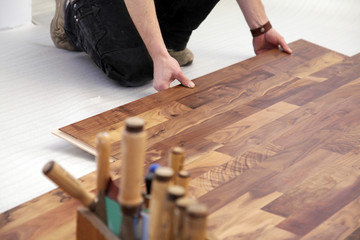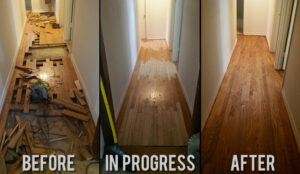Advantages of Laminate Flooring
Laminate Flooring is a low-maintenance, durable, and attractive flooring option that you can use in your home or business. It’s one of the most popular flooring types on the market today. Laminate floors expose aggregated wood particles to high pressure.

Laminate floors are extremely durable and resist abrasion, scuffs, scratches, and dents. Laminates are virtually immune to stains and spills and can even be five times more scratch resistant than hardwood.
The durability of laminate flooring is enhanced by its tough melamine wear layer and resin coating. These layers prevent scratches from stains and other damage, making them ideal for high-traffic areas and homes with pets and children.
In addition, the decorative layer replicates the appearance of natural wood, stone, or tile by printing a photo image over the top. This gives the laminate its realistic look and creates a great illusion of real wood.
Water-resistant versions can also be purchased that repel water for a specified period, but once moisture penetrates the surface or the locking system, warping and swelling can ruin the floor. The best way to protect your laminate floor from this damage is to avoid placing it in rooms that will experience frequent moisture and if you must use it, choose one that is waterproof.
Laminate flooring is easy to maintain, and you don’t have to spend time sanding or refinishing it as often as hardwood floors. Its durable wear layer protects it from scratches, stains, and dents and can resist sun fading.
Taking simple preventative measures like using door mats or area rugs at entryways will help keep dirt and debris from scratching the surface of your laminate floor. Similarly, place furniture pads under the legs of chairs and tables to avoid scratching the protective wear layer.
Clean up spills promptly and don’t let liquids stand for long periods on your laminate floors as it can cause stains and damage the protective wear layer.
Invest in a good quality broom and sweep your floors daily or semi-regularly. Occasionally, you will want to deep clean your floors by using a damp mop or cleaning cloth with warm water and neutral detergent. This helps eliminate dirt, pet dander, mud, and more.
Laminate flooring manufacturers offer a vast array of patterns, colors, and textures, providing homeowners with an impressive selection of laminate options. Unlike hardwood floors which require a lot of care and maintenance, laminates are more resistant to scratches, stains, and dents.
Aside from being highly durable, laminates also look great. With the help of innovative printing and image separation processes, a wide range of patterns and variations are now available in laminates.
Wood-grain pattern laminates in particular, have gotten a boost from computer programs that produce grain patterns that look more complex than ever. In addition, manufacturers are also bringing forth products that mimic stone and tile patterns.
To make a flooring pattern look as realistic as possible, the laminate sheet is covered with an overlay (or wear layer) made from melamine resin or – in parquet floors – from specific paints. The printed decorative paper is positioned on top of these layers, which are then adhered to a high-density fiberboard core.
Laminate is a great option for people on a budget. It is easy to install and offers a wide range of design options for your home or office.
It’s also very durable and easy to care for. It has an aluminum-oxide wear layer that makes it resistant to scratches, scuffs and other damage.
You can find a variety of affordable laminate floors that look like wood and stone at a fraction of the cost of real hardwoods or stone tiles. Choosing the right one for your home can help your flooring last many years.
Laminate flooring refers to a type of flooring material that is made of multiple layers of synthetic materials that are fused using heat and pressure. The top layer of laminate flooring is typically a high-resolution image of a natural material, such as wood or stone. A protective layer of clear melamine resin covers that.
Laminate flooring is a popular and cost-effective alternative to natural hardwood, stone, or tile flooring. It is easy to install and can be used in various settings, including residential and commercial applications. Laminate flooring is also durable, scratch-resistant, and easy to maintain.
Laminate flooring comes in various colors, patterns, and textures to suit any design style. It can be installed over existing flooring, such as concrete, vinyl, or a subfloor. Laminate flooring can be installed using a floating method, which involves interlocking the planks together or by gluing the planks directly to the subfloor.
Steps in Floor Refinishing
If your hardwood floors have been worn down, you may want to consider Floor refinishing. It can be less expensive than replacing them and is less invasive to your home.

To determine whether a floor refinishing is right for your home, start with an honest assessment of the damage. It’s best to get a free consultation from an expert.
Sanding is an essential step in any hardwood floor refinishing project. It can help remove light scratches and stains, and it can even give the wood a new look. It can also help prepare a wood floor for staining or applying a protective coating of paint, lacquer or polyurethane.
There are many different types of abrasives to choose from when sanding. Some of the most common include silicon carbide, abrasive paper, abrasive cloth and ceramic. Regardless of what type of abrasive you use, it’s important to understand the differences between each.
Abrasives come in various sizes, shapes and grits. These vary in hardness, and each grit has its own characteristics, such as whether it’s coarse or fine.
The most important thing to remember when sanding is to keep the abrasive in contact with the floor. This ensures that the abrasive isn’t scratching the floor or causing damage to the finish.
If you’re using a drum sander, wear safety goggles, ear protection and a dust mask while operating the sander. Work the sander in long overlapping strokes, moving parallel to the direction of the boards, not across the wood grain.
To reduce the amount of wood dust produced, switch sandpaper frequently. It’s also important to sand in well-ventilated areas.
It’s a good idea to sand the floor in stages, starting with coarse paper and working your way up to finer grits. This way, you’re not cutting the wood too much or causing more harm than necessary.
Depending on the condition of the floor, you may need to stand more than once before it is completely smooth. Generally, hardwood floors can accept up to three deep sandings before they’re ruined.
If you’re sanding an older or very hard floor, it’s best to start with 36-grit sandpaper, rather than the coarser 24 or 16 grits used for a fresh, new floor. This can be especially true if the floor hasn’t been sanded in some time or has a heavy coating of paint or other finish on it.
Staining is a step in floor refinishing that involves applying a color-changing chemical to the wood. It can enhance the wood’s natural grain or create a new pattern. It also protects the wood from wear and tear.
There are many different types of stains, ranging from very light to dark and from water-based to oil-based. The type of stain you choose depends on the purpose of your project. For instance, a woodworker might prefer an alcohol-based stain for its ease of application and its ability to penetrate deep into the wood fibers.
Oil-based stains tend to result in more richly colored finishes than water-based stains, and they’re ideal for hard woods such as oak. However, they’re toxic and need decent ventilation. They can be applied with a brush, but use mineral spirits to clean the brush before you start applying the stain.
Whether you apply the stain with a brush or a rag, try to apply enough of it to cover the entire surface of the wood. This will minimize overlap marks that will make the finish look uneven and patchy.
If you’re staining a hardwood floor, consider choosing an alcohol- or spirit-based stain, which dry faster than traditional water-based stains. These stains are easier to apply with a brush and are ideal for wood with thick grain.
It’s a good idea to test the stain on scrap wood, so you can get the right shade. Then, follow the manufacturer’s directions for how much to apply and where to apply it.
When you’re finished, leave it to dry for 24 hours. Then, apply a protective coating called a clear finish. A coat of this will give your floors a polished, lustrous sheen and help them stand up to daily wear.